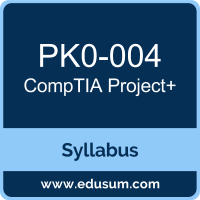 Use this quick start guide to collect all the information about CompTIA Project+ (PK0-004) certification exam. This study guide provides a list of objectives and resources that will help you prepare for items on the PK0-004 Project+ exam. The Sample Questions will help you identify the type and difficulty level of the questions and the Practice Exams will make you familiar with the format and environment of an exam. You should refer this guide carefully before attempting your actual CompTIA Project Plus certification exam.
Use this quick start guide to collect all the information about CompTIA Project+ (PK0-004) certification exam. This study guide provides a list of objectives and resources that will help you prepare for items on the PK0-004 Project+ exam. The Sample Questions will help you identify the type and difficulty level of the questions and the Practice Exams will make you familiar with the format and environment of an exam. You should refer this guide carefully before attempting your actual CompTIA Project Plus certification exam.
The CompTIA Project+ certification is mainly targeted to those candidates who want to build their career in Additional Professional domain. The CompTIA Project+ exam verifies that the candidate possesses the fundamental knowledge and proven skills in the area of CompTIA Project Plus.
CompTIA Project+ Exam Summary:
| Exam Name | CompTIA Project+ |
| Exam Code | PK0-004 |
| Exam Price | $358 (USD) |
| Duration | 90 mins |
| Number of Questions | 95 |
| Passing Score | 710 / 900 |
| Schedule Exam | Pearson VUE |
| Sample Questions | CompTIA Project+ Sample Questions |
| Practice Exam | CompTIA PK0-004 Certification Practice Exam |
CompTIA PK0-004 Exam Syllabus Topics:
| Topic | Details |
|---|---|
Project Basics - 36% |
|
| Summarize the properties of a project. |
- Temporary - Start and finish - Unique - Reason/purpose - Project as part of a program - Project as part of a portfolio |
| Classify project roles and responsibilities. |
- Sponsor/champion
- Project manager
- Project coordinator
- Stakeholder
- Scheduler
- Project team
- Project Management Office (PMO)
|
| Compare and contrast standard project phases. |
- Initiation
- Planning
- Execution
- Monitor and control
- Closing
|
| Identify the basics of project cost control. |
- Total project cost - Expenditure tracking - Expenditure reporting - Burn rate - Cost baseline/budget
|
| Identify common project team organizational structures. |
- Functional
- Matrix
- Projectized
|
| Given a scenario, execute and develop project schedules. |
- Work breakdown structure - Scheduling activities
|
| Identify the basic aspects of the Agile methodology. |
- Readily adapt to new/ changing requirements - Iterative approach - Continuous requirements gathering - Establish a backlog - Burndown charts - Continuous feedback - Sprint planning - Daily standup meetings/ SCRUM meetings - SCRUM retrospective - Self-organized and self-directed teams |
| Explain the importance of human resource, physical resource, and personnel management. |
- Resource management concepts
- Personnel management
|
Project Constraints - 17% |
|
| Given a scenario, predict the impact of various constraint variables and influences throughout the project. |
- Common constraints
- Influences
|
| Explain the importance of risk strategies and activities. |
- Strategies
- Risk activities
|
Communication & Change Management - 26% |
|
| Given a scenario, use the appropriate communication method. |
- Meetings
- Email |
| Compare and contrast factors influencing communication methods. |
- Language barriers - Time zones/geographical factors - Technological factors - Cultural differences - Interorganizational differences - Intraorganizational differences - Personal preferences - Rapport building/relationship building - Tailor method based on content of message - Criticality factors - Specific stakeholder communication requirements
|
| Explain common communication triggers and determine the target audience and rationale. |
- Audits - Project planning - Project change - Risk register updates - Milestones - Schedule changes - Task initiation/completion - Stakeholder changes - Gate reviews - Business continuity response - Incident response - Resource changes |
| Given a scenario, use the following change control process within the context of a project. |
- Change control process
- Types of common project changes
|
| Recognize types of organizational change. |
- Business merger/acquisition - Business demerger/split - Business process change - Internal reorganization - Relocation 6. Outsourcing |
Project Tools & Documentation - 21% |
|
| Compare and contrast various project management tools. |
- Project scheduling software - Charts
- Dashboard/status report
- Performance measurement tools
- SWOT analysis |
| Given a scenario, analyze project centric documentation. |
- Project charter - Project management plan - Issues log - Organizational chart - Scope statement - Communication plan - Project schedule - Status report - Dashboard information - Action items - Meeting agenda/meeting minutes |
| Identify common partner or vendor-centric documents and their purpose. |
- Request for Information - Request for Proposal - Request for Quote - Mutually binding documents
|
To ensure success in CompTIA Project Plus certification exam, we recommend authorized training course, practice test and hands-on experience to prepare for Project+ (PK0-004) exam.
